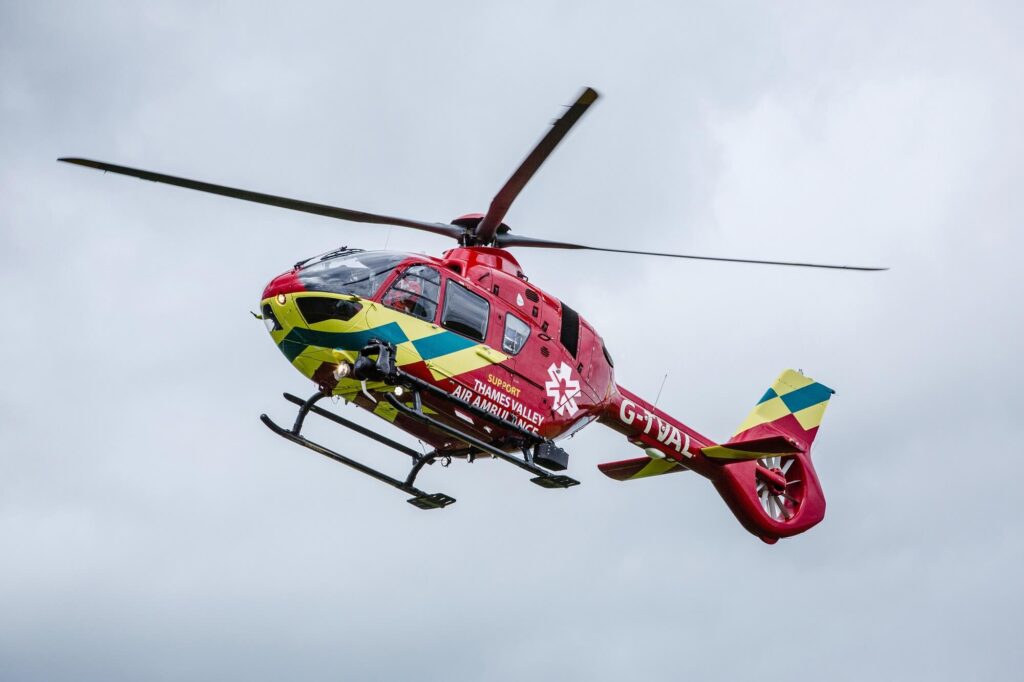Getting permission to enter an active Royal Air Force base is always exciting. Therefore, my day at RAF Benson, nestled in the UK’s Oxfordshire countryside, to meet the Chief Executive Officer of Thames Valley Air Ambulance was never going to disappoint. As we passed the Spitfire guarding the main gate of the base, Amanda McLean soon got to work telling me about her operations and her pride in the lifesaving team we were about to meet.
McLean talks about the Thames Valley Air Ambulance operations like a 30-year veteran of aviation. However, this knowledgeable, focussed, and tenacious chief executive is in fact a relative newcomer with barely six years at the helm of the service. She is clearly a fast learner because she has mastered the complexities of aviation regulation to such a degree that the service is now in the final throes of achieving approval of its own Air Operators Certificate (AOC) from the UK CAA.
Since joining the organization in 2016, McLean has more than doubled staff numbers and recently launched a new strategy with the aim of dramatically increasing its fundraising target to £14 million ($16.9 million) annually by the end of 2025.
The organization boasts around 120 people, an annual turnover of around £10 million ($12.1 million), plus a fleet of one helicopter, five critical response road vehicles, and a van “for transporting blood and plasma daily to and from the local hospitals”, all of which McLean runs with extreme pride. As she sees me staring past the road vehicles towards the helicopter in the distance, she jokes, “Some of our vehicles have four wheels instead of four blades, but I know you’re not really interested in that!”
And she is right. I’ve always loved the ‘blues and twos’ but today is all about the EC135 and its critical work. From the moment they get a callout, the Thames Valley team can scramble and be airborne within six minutes. With a cruising speed of around 120 knots (135 miles per hour), the EC135, with registration G-TVAL, can reach anywhere in the three English counties the air ambulance covers within 15 minutes. It’s not uncommon for the helicopter to fly from one emergency to another, and so the 220-mile range (with normal fuel and payload) allows it to operate multiple missions before returning to base.
Prior to taking up the CEO baton at Thames Valley Air Ambulance, Amanda McLean had built her career in the charity sector. Having started in fundraising, she worked up through the ranks, taking on her first CEO role in 2008. Her focus has been mainly in the healthcare and charitable sectors, with medical research and fundraising dominating her career. Although she admits to not being an aviation enthusiast prior to taking on the role, she has since been bitten by the aviation bug and is becoming more and more of an industry expert by the day.
Amanda explains that the ‘service’ is all about giving people the best chance when the worst happens and that their job is to bring the emergency room to the patients when they most need it.
“First and foremost, we are a medical emergency response operation, and we utilise the speed and flexibility offered to us by our helicopter service to get the critical care experts to the people who need them as quickly as possible. There is no doubt that aviation has played a key role in providing lifesaving treatments to countless number of people since 1999 when our first air ambulance service took to the skies.”
Today, McLean oversees the many varied operations and requirements of Thames Valley Air Ambulance. Along with her team, she is 100% focused on getting the critical care experts and equipment to the people who need it as quickly as possible. The charity is fully funded by the generosity of community fundraising. Serving and protecting a community of 2 million people across three counties in the UK, Berkshire, Oxfordshire, and Buckinghamshire, the air ambulance team was last year called out to almost 3,000 emergencies.
McLean is clear about her duty and responsibility. “At the end of the day, I am just the conductor of a fast-expanding orchestra. If we are not all in tune and in time, I am not doing my job properly. Our purpose is to give everyone within our community the best chance of surviving and recovering from an emergency, and every single member of the team across our head office and our aviation operation at RAF Benson is focused on that single objective.”
There’s more to come, McLean says. “As we continue to deliver our new 2025 strategy, we will increase our operations and ultimately help more and more people when they really need us, and G-TVAL is a critical part of what we do.”
“I’m proud of our team, and I am proud of the community service we provide. There is a lot of work to do in order to achieve our 2025 goals, but I’m confident that our team is ready to take on that challenge and continue to develop our service, ultimately helping more and more people when they need us most.”
You can watch the crew of G-TVAL in action on the ‘Emergency Helicopter Medics’ television programme on More4 and catch up TV in the UK.
